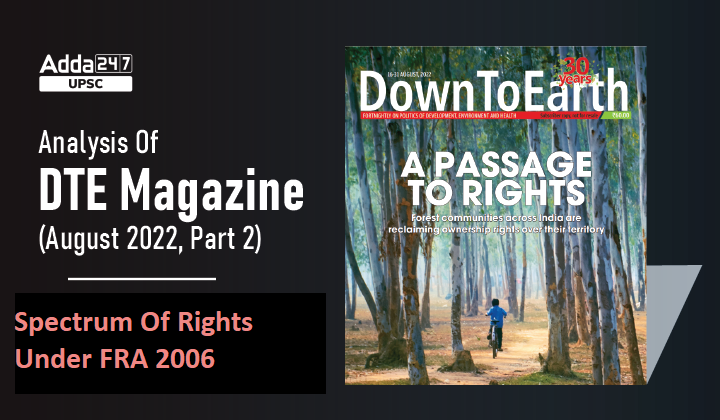Table of Contents
Down To Earth Magazine is a fortnightly magazine focusing on politics of environment and development, published in New Delhi, India.
UPSC Previous years’ questions on Development, Environment, Health and Disaster Management give us a clear idea about the increased importance of Down To Earth Magazine.
Down To Earth Magazine is one of the most important and indispensable sources for UPSC Civil Services Exam Preparation.
Keeping this in mind, here, we come with ”Gist Of Down To Earth Magazine” which covers important environmental current affairs articles in smooth pointed form, keeping in mind the demand of UPSC aspirants.
Spectrum Of Rights Under FRA 2006: Why in news?
- The Forest Rights Act 2006 has the potential to transform the lives and livelihoods of more than 150 million forest-dependent people, states the “Promise and Performance of the Forest Rights Act, 2006: The Tenth Anniversary Report”.
Spectrum Of Rights Under FRA 2006: Background
- In 2006, the Parliament enacted The Scheduled Tribes and Other Traditional Forest Dwellers (Recognition of Forest Rights) Act, 2006 (referred to as the Forest Rights Act or FRA).
Spectrum Of Rights Under FRA 2006: What kind of rights does the FRA 2006 provide?
- The Forest Rights Act(FRA) 2006 grants forest communities individual rights, community rights and community forest resource rights, with the latter having the broadest scope
- The law vests a number of rights to Forest Dwelling Scheduled Tribes (FDSTs) and Other Traditional Forest Dwellers (OTFDs), including individual and community rights over forestlands, and the rights to protect and manage community forest resources within the traditional or customary boundaries of the villages.
- FRA recognises 14 types of pre-existing rights of forest dwellers on all categories of forestland, including protected areas.
- The most significant rights are included in Section 3(1) of the Act.
Rights provided in Section 3(1) of the FRA 2006
The most significant rights are included in Section 3(1) of the Act and they are:
(I) Individual forest rights (IFRs)
Under section 3(1)(a) allow tribal people to secure individual tenures under FRA, which include the right to hold and live on the forestland under the individual or common occupation for habitation or for self-cultivation for livelihood by a member or members of a forest dwelling Scheduled Tribe or OTFD.
(ii) Community forest rights (CFR)
- Under section 3(1) (b) to 3(1)(m), allow for the use of and access to forestland and resources.
- These comprise rights such as nistar (traditional community use rights recorded in the nistarpatrak), including those used in erstwhile princely states, zamindari or such intermediary regimes;
- Rights of ownership and access to collect, use and dispose of minor forest produce (non-timber forests products or NTFP) that has been traditionally collected within or outside village boundaries;
- Rights of uses or entitlements to fish and other products of waterbodies;
- Rights of grazing (both settled or transhumant) and traditional seasonal resource access of nomadic or pastoralist communities; right of access to biodiversity; and
- Community right to intellectual property and traditional knowledge related to biodiversity and cultural diversity and any other traditional right.
(iii) Community forest resource rights (CFRR)
- To use, manage and govern forests within the traditional boundaries of villages.
- This right pertains especially to Section 3 (1) (i): “right to protect, regenerate, or conserve or manage any community forest resource, which they have been traditionally protecting and conserving for sustainable use”.
- This is the most significant right as it gives the community the right to manage and protect the customary common forest land within its traditional or customary boundaries.
- Clearly, the extent of CFRR would be coterminous with or a subset of community rights (as it pertains to the access and use of forest area over which the gram sabha also believes it has customary management rights).
- CFRR gives forest communities the right to collect, store, process and sell NTFP.
- The right allows the community to formulate rules for forest use by itself under Section 5 of FRA.
Note: The ownership of the forest passes into the hands of the gram sabha of the villages instead of the forest department and they are free to form their own rules and regulations for management, use and conservation by adopting their age-old traditional practices.
The amendment in the FRA rules in 2012
- The 2012, amendment in the FRA rules provided for specific form C for claiming CFRR.
- The form C defines provisions to claim for CFRR, and states: “We, the undersigned residents of this Gram Sabha, hereby resolve that the area detailed below and in the attached map comprises our Community Forest Resource over which we are claiming recognition of our forest rights under Section 3(1)(i) (of the Act)”.
- So, most gram sabhas started claiming this right after that.
- However, Gujarat and Odisha had started claiming the rights three years before this amendment, under “Other rights” columns in form B.
- The 2012 amendment and inclusion of form C, only describes the rules for community rights claims and provisions in more detail.
- Since 2012, there has been a significant rise in the number of forest communities and villages demanding CFR.



 TSPSC Group 1 Question Paper 2024, Downl...
TSPSC Group 1 Question Paper 2024, Downl...
 TSPSC Group 1 Answer key 2024 Out, Downl...
TSPSC Group 1 Answer key 2024 Out, Downl...
 UPSC Prelims 2024 Question Paper, Downlo...
UPSC Prelims 2024 Question Paper, Downlo...





